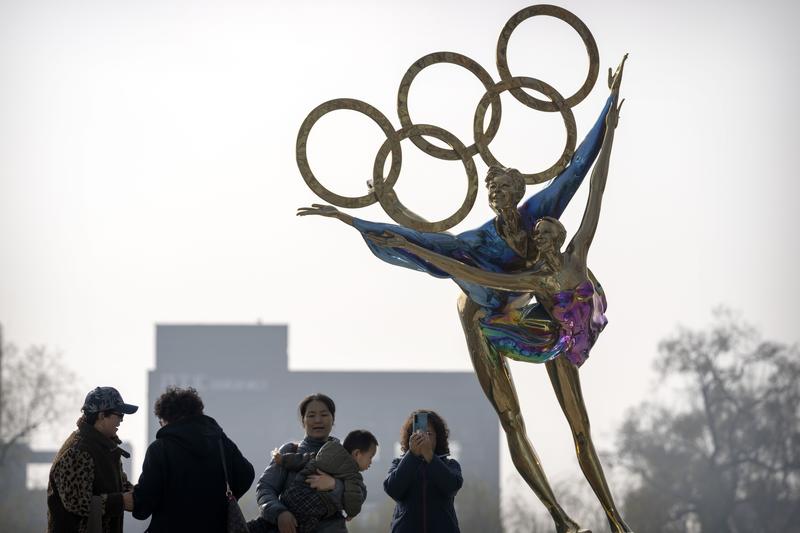City makes facilities energy efficient and environment better before event
 Visitors take photos of a statue of figure skaters with the Olympic rings at a park near the headquarters of the Beijing Organizing Committee for the Olympic Games (BOCOG) in Beijing, Nov 18, 2021. (MARK SCHIEFELBEIN / AP)
Visitors take photos of a statue of figure skaters with the Olympic rings at a park near the headquarters of the Beijing Organizing Committee for the Olympic Games (BOCOG) in Beijing, Nov 18, 2021. (MARK SCHIEFELBEIN / AP)
Adhering to the principles of green, low-carbon and sustainable development, Beijing has made facilities and venues for next year's Winter Olympic Games energy efficient in the hope of continuously improving the city's environment before and during the Games, municipal officials said on Tuesday.
"From the bid to preparations for the 2022 Winter Olympics, Beijing has taken various measures to create a city with a better ecological environment," Yu Jianhua, deputy director of the Beijing Municipal Ecology and Environment Bureau, told a news conference.
"We hope a new look for the capital will benefit more citizens earlier."
A total of 550 kilometers of streets along Beijing's rivers and lakes have been reconfigured for use by cyclists and pedestrians, according to the city's overall urban plan.
A waterfront pathway running 28.5 kilometers from the capital's downtown to its subcenter in the eastern Tongzhou district opened to the public last year, said Yang Jinhuai, deputy director of the Beijing Water Authority.
In addition, mountains and parks in the Haidian district have gradually formed open river and lake space, he said, adding that citizens can easily enjoy the places, whether they participate in fast walking, slow riding, fishing in summer or skating in winter.
More than 10 public skating rinks on urban rivers and lakes open to the public every winter in Beijing, and a series of public ice and snow experience activities is being planned in the city this winter, Yang said.
Lu Changrong, a 70-year-old resident of Haidian, said he was glad an abandoned quarry near his home was turned into a public fitness park with trails and sports facilities.
"The park completed renovation in October, and since then I come here to exercise twice a day, in the morning and afternoon," he said.
The Games venues have applied high-standard green design and construction techniques and stuck to energy efficiency and environmental conservation to better protect the environment and leave a green Olympic legacy, said Ding Sheng, deputy head of the Beijing Municipal Housing and Urban-Rural Development Commission.
All newly built Winter Olympics venues have obtained the three-star green building evaluation label, the highest level, Ding said.
"The National Speed Skating Oval uses the world's most environmentally friendly ice-making technology to make its carbon emissions approach zero," he said, adding that the venue used carbon dioxide direct evaporative cooling.
The track at the National Sliding Center in Yanqing district is the world's first with its awnings covered completely, and the awnings can effectively reduce the influence of weather on the ice surface to minimize the energy loss of the track, said Ding.
When it was under construction, the National Alpine Ski Center used topsoil stripping and recycling techniques to prevent soil erosion, protect primary seed banks and reduce the chance of alien invasive species taking root in the competition area, he said.
Beijing will also actively nurture a batch of cutting-edge industries as the 2022 Winter Olympics approach, said Li Tao, a senior official with the Beijing Economy and Information Technology Bureau.
Last year, the high-tech industries in the capital achieved an added value of 988 billion yuan ($155 billion), accounting for 27.4 percent of the region's GDP.
By the end of 2025, the level of green development in the city will be more significant, he said.


